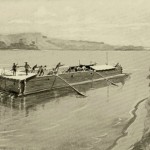Ramshackle barns exhorting passers-by to “treat [themselves] to the best” have become a familiar element of road-trip vernacular. Those wandering down Indiana’s scenic routes, or browsing around the courthouse square in certain county seats are sure to encounter the fading call to action–“Chew Mail Pouch Tobacco”. Soon after the product’s birth in Wheeling, West Virginia around 1900, its makers launched a national advertising campaign that focused on rural areas in the Midwest.
Chewing tobacco was especially convenient for the large number of farmers in the Hoosier State whose daily routine limited their opportunities to smoke. Indiana farmers were targeted not only as Mail Pouch customers, but partners in what became a century-long marketing campaign. In exchange for a small sum (usually under ten dollars), a yearlong supply of tobacco, or a magazine subscription, a farmer would agree to have the company’s slogan painted on his barn. Having at least one side of a barn painted for free provided additional incentive. Regionally-contracted two-man painting crews knocked out two to three barns a day, working for commissions that compensated them by the square foot.
Other signs were painted on the brick walls of corner buildings visible from the state’s county courthouses. Each advertisement was signed and dated. A common set of initials—H..E.W.—indicates that the sign was the work of Harley Warrick, an Ohio native who painted around twenty thousand barns in twenty states for the Mail Pouch firm, never utilizing stencils or modern scaffolding. “Name an Indiana town of any size,” Warrick claimed, “and I’ve been there.”
The Federal Highway Beautification Act of 1965, prohibiting highway signage closer than 660 feet from the roadway, resulted in many of the Mail Pouch barns to be painted over. The advertising campaign was further weakened as the burgeoning interstate highway system reduced traffic on the state roads from which the barns were visible. Mail Pouch signs all but went the way of Burma Shave by 1969.
In 1974, however, Congress made an exception for commercial signs of historic significance, and Warrick, the firm’s only remaining sign painter, went about restoring Mail Pouch signs around the country—completing major projects in the Indiana towns of Redkey and Lanesville. With increasing societal consciousness of the health hazards of tobacco, Mail Pouch ended its legendary ad campaign upon Warrick’s retirement, in 1996. Some landowners who have Mail Pouch barns on their property choose to maintain them, while other long-gone signs return as ghost images when a barn’s more recent paint jobs give way to the indelible lead-based letters underneath. Although many have been razed, some Mail Pouch barns have been dismantled to be reassembled for long-term preservation in such settings as Cincinnati’s American Sign Museum.






















